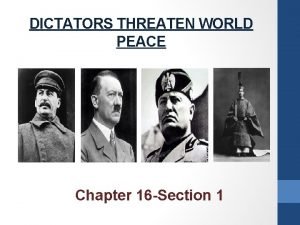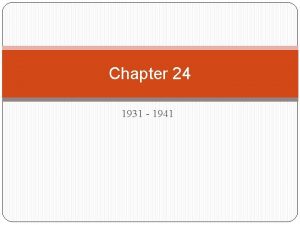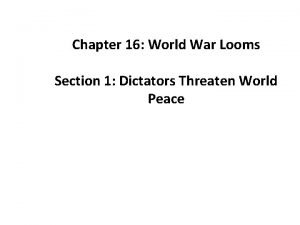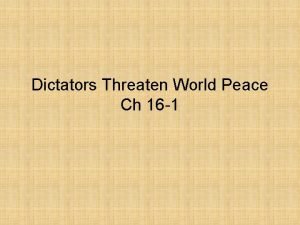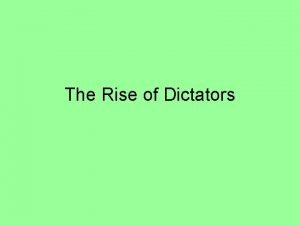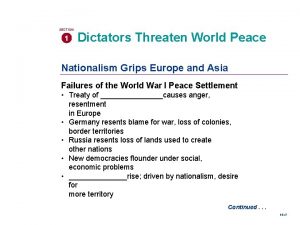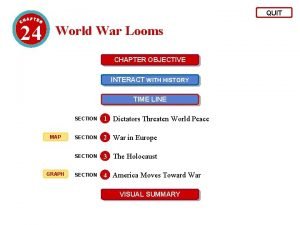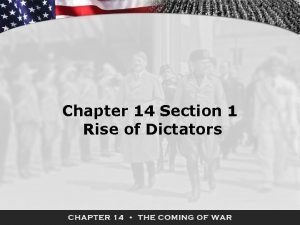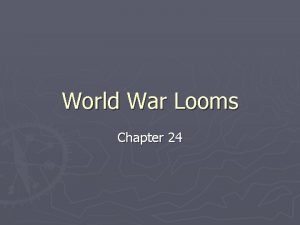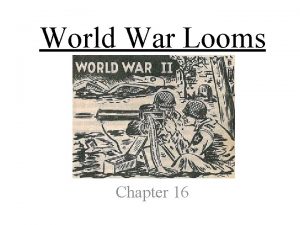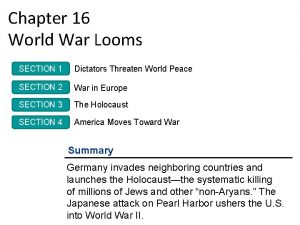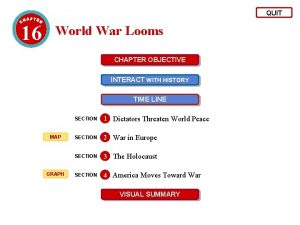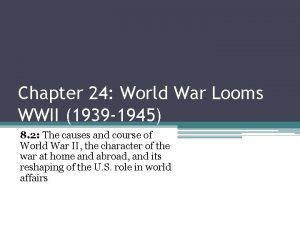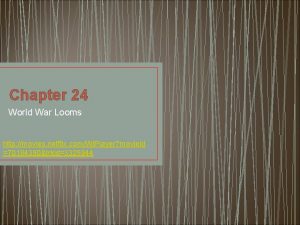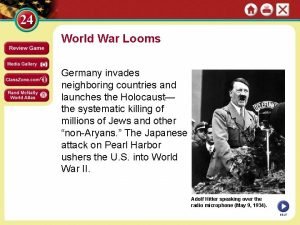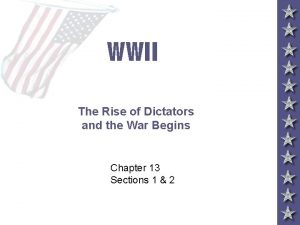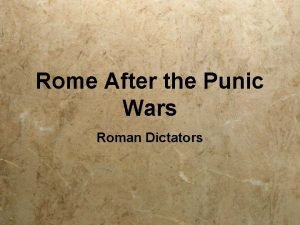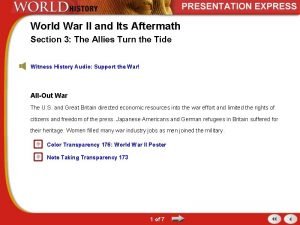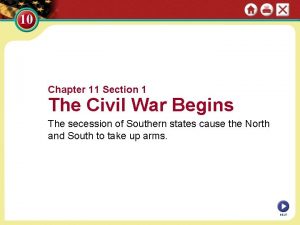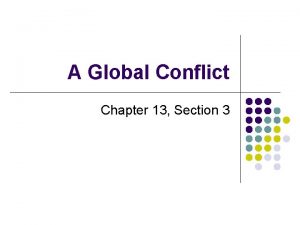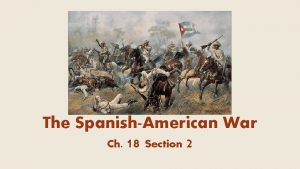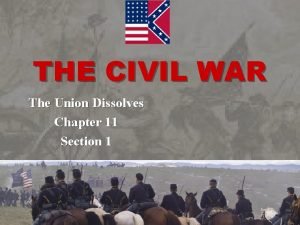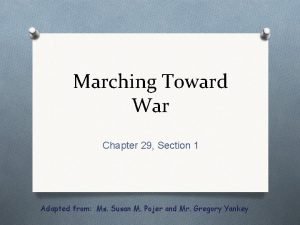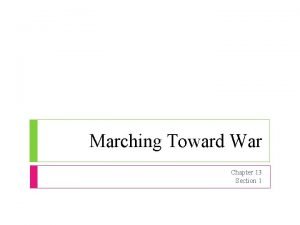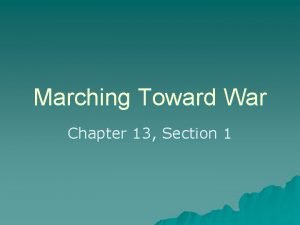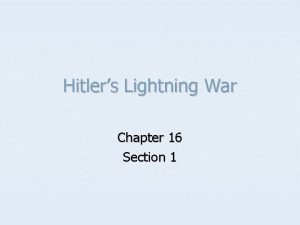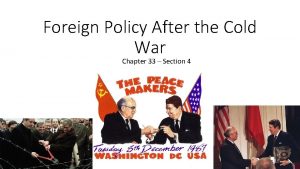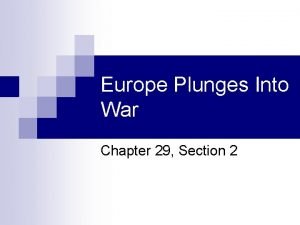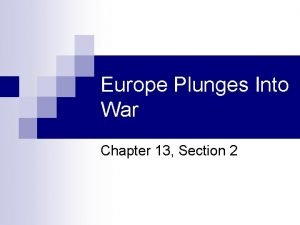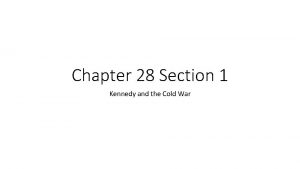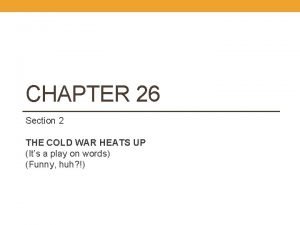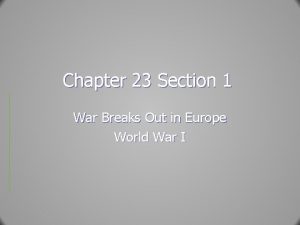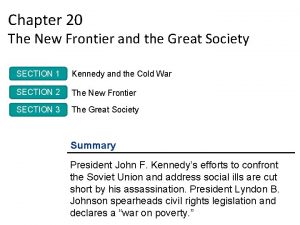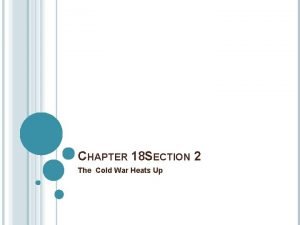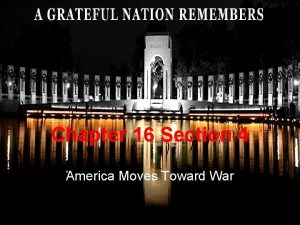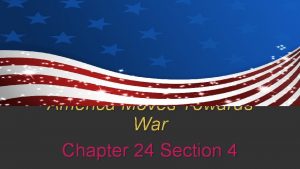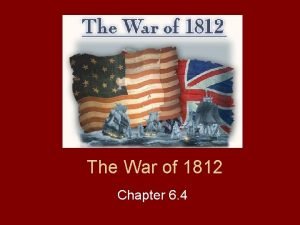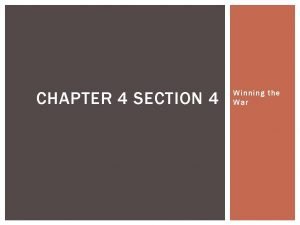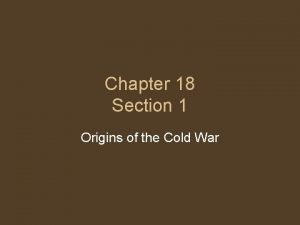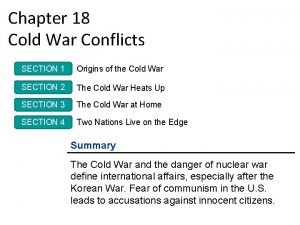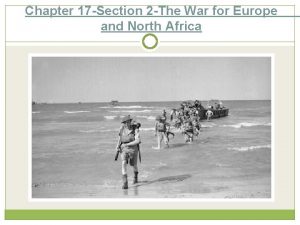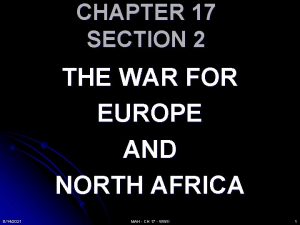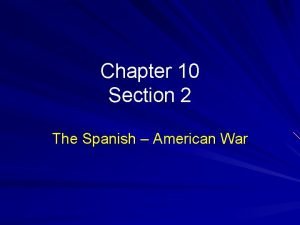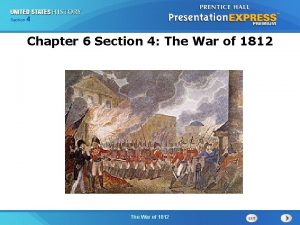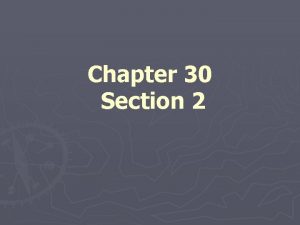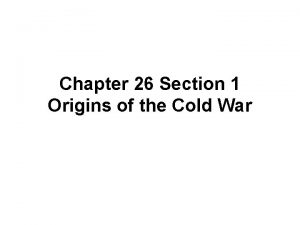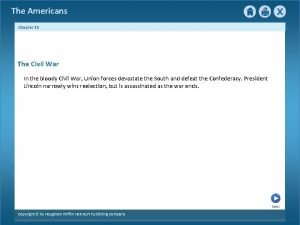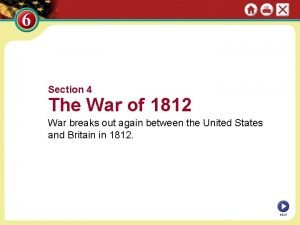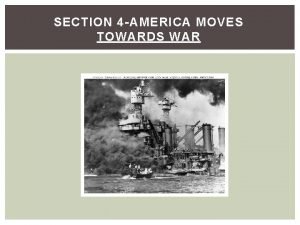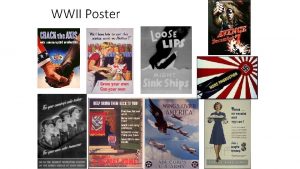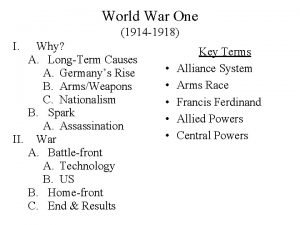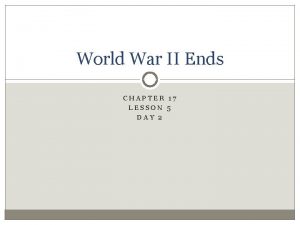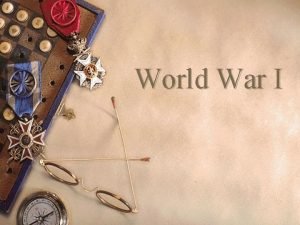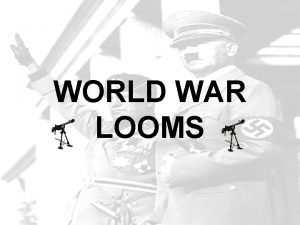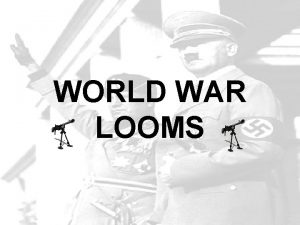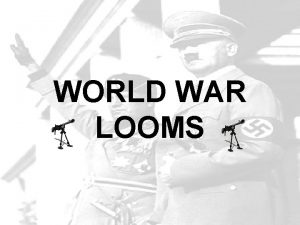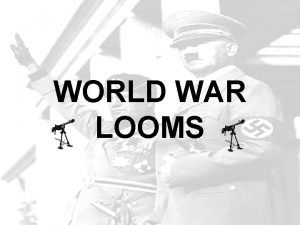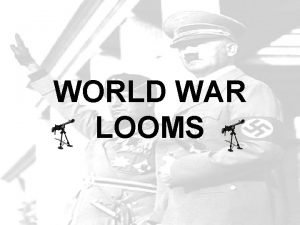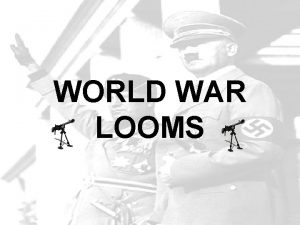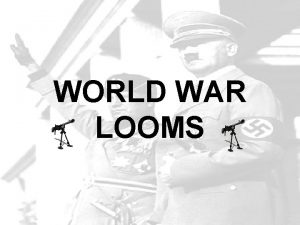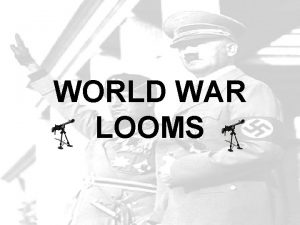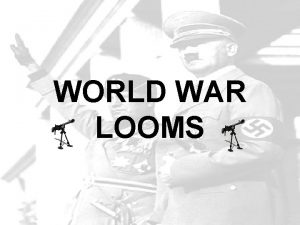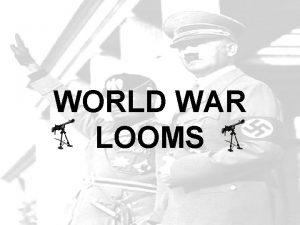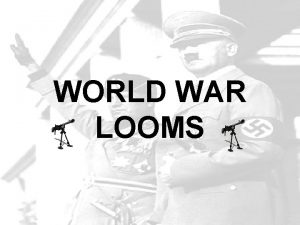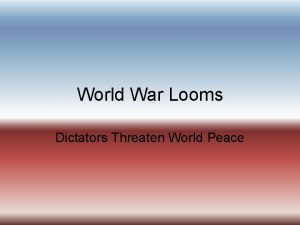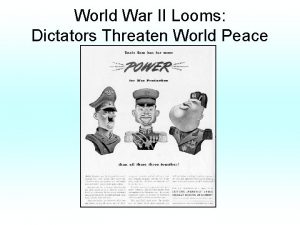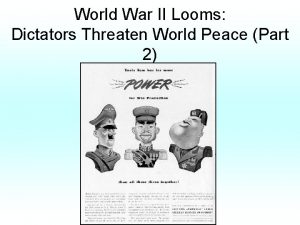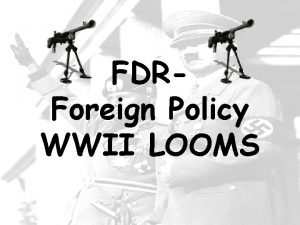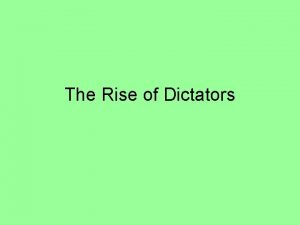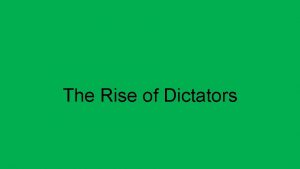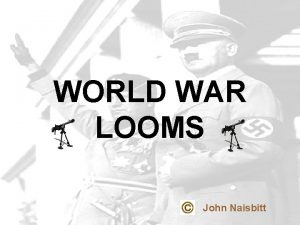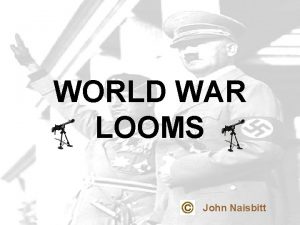WORLD WAR LOOMS SECTION 1 DICTATORS THREATEN WORLD









































































- Slides: 73

WORLD WAR LOOMS

SECTION 1: DICTATORS THREATEN WORLD PEACE • For many European countries the end of World War I was the beginning of revolutions at home, economic depression and the rise of powerful dictators driven by nationalism and territorial expansion Two powerful 20 th Century dictators were Stalin & Hitler

FAILURE OF VERSAILLES The Versailles Treaty (above on crutches) took a beating in the U. S. and abroad • The peace settlement that ended World War I (Versailles Treaty) failed to provide a “just and secure peace” as promised • Instead Germany grew more and more resentful of the treaty that they felt was too harsh and too punitive

JOSEPH STALIN TRANSFORMS THE USSR Stalin (right), shown here with Lenin, ruled Russia with an iron fist for nearly 30 years • After V. I. Lenin died in 1924, Joseph Stalin took control of the Soviet Union • His goals included both agricultural and industrial growth • Stalin hoped to transform the USSR from a backward rural nation to a major industrial power


STALIN’S PLANS • In the first year of his “ 5 -year plan” Stalin placed all economic activity under strict state control • By 1937, Stalin had achieved his goal– USSR was the world’s 2 nd largest industrial power This 1932 poster championed the Soviet Defense industry

STALIN MURDERS MILLIONS OF SOVIETS Labor camp workers in Siberia -Stalin sent millions of political prisoners to labor camps • In his desire to purge (eliminate) anyone who threatened his power, Stalin was responsible for the deaths of 8 – 13 million of his own Soviet citizens • Millions more died of famine caused by his economic policies

TOTALITARIAN STATE • By 1939, Stalin firmly established a totalitarian government in the USSR • In a totalitarian state the government suppresses all opposition and has strict control over the citizens who have no civil rights In totalitarian states citizens are expected to treat the dictator with adoration

THE RISE OF FASCISM IN ITALY • While Stalin was consolidating his power in the Soviet Union, Benito Mussolini was establishing a totalitarian regime in Italy • Mussolini seized power, taking advantage of high unemployment, inflation and a middle-class fear of Communism


MUSSOLINI CREATES FASCIST PARTY • Mussolini was a strong public speaker who appealed to Italian national pride • By 1921, Mussolini had established the Fascist Party -- Fascism stressed nationalism and militarism and placed the interest of the state above the interests of the individual

NAZIS TAKE OVER GERMANY Hitler, far left, shown during WWI • Meanwhile in Germany, Adolf Hitler followed a similar path to Mussolini • At the end of WWI he was a jobless soldier drifting around Germany • In 1919, he joined a struggling group called the National Socialist German Workers’ Party (Nazis) • (Despite its name the party had no ties to socialism)


WEIMAR REPUBLIC RULES GERMANY • The victors installed many new democratic governments in Europe after World War I including the Weimar Republic in Germany • Most were overwhelmed from the start and struggled economically A German woman is seen here in 1923 feeding bundles of money into the furnace. . . why?

Exchange rates, US Dollar to Mark, 1918 -1923 Source : Gerald D. Feldman, The Great Disorder, Oxford : UP 1997, p. 5 Jan. 1918 Jan. 1919 Jan. 1920 Jan. 1921 Jan. 1922 April 1922 July 1922 Oct. 1922 Jan. 1923 Feb. 1923 5. 21 8. 20 64. 80 64. 91 191. 81 291. 00 493. 22 3, 180. 96 17, 972. 00 27, 918. 00 Mar. 1923 Apr. 1923 May 1923 June 1923 July 1923 Aug. 1923 Sept. 1923 Oct. 1923 Nov. 1923 Dec. 1923 21, 190. 00 24, 475. 00 47, 670. 00 109, 966. 00 353, 412. 00 4, 620, 455. 00 98, 860, 000. 00 25, 260, 000. 00 2, 193, 600, 000. 00 4, 200, 000, 000. 00

This Konstanz 50 Milliarden (million) Mark overprinted on 5 Mark illustrates the extend of the inflation in Weimar Germany

HITLER GAINS FOLLOWING • Hitler’s ability as a public speaker and organizer drew many followers • He quickly became the Nazi Party leader • Calling himself “Der Fuhrer” (the leader) he promised to return Germany to its old glory

Hitler rose to power in part by criticizing the Versailles Treaty as unfair and humiliating to the proud German nation

HITLER’S BELIEFS He alone, who owns the youth, gains the Future! -- Adolf Hitler, speech at the Reichsparteitag, 1935 • Hitler explained his beliefs in his book, Mein Kampf (My Struggle) • He wanted to unite all German-speaking people under one grand Empire • He wanted racial purity – “inferior” races such as Jews, Slavs and all nonwhites were to form a work force for the “master race” – blond, blue-eyed “Aryans”

LEBENSRAUM • Another element of Hitler’s grand design was national expansion • Hitler called it “Lebensraum” or living space • Hitler believed that for Germany to thrive it needed more land at the expense of her neighbors Hitler posed an immediate threat to Czechoslovakia, Poland, Austria, France, Belgium and the Netherlands

HITLER APPOINTED CHANCELLOR Hitler was appointed chancellor by the aging President Hindenburg of the Weimar Republic • By mid-1932, the Nazis had become the strongest political party in Germany • In January of 1933, Hitler was appointed Chancellor (Prime Minister) • Once in office he quickly dismantled Germany’s democratic Weimar Republic and replaced it with a totalitarian government

THE THIRD REICH • Once in power, Hitler established the Third Reich, or Third German Empire • The first was during the Middle Ages and the Second came with the Unification of Germany in 1871 • According to Hitler the Third Reich would last 1, 000 years

MILITANTS GAIN CONTROL OF JAPAN • Halfway around the world, nationalistic leaders were seizing control of the Imperial government of Japan • Like Hitler, they desired living space for their growing population

JAPAN IN THE 1930 s • The 1930 s were years of fear in Japan, characterized by the resurgence of right-wing patriotism, the weakening of democratic forces, domestic terrorist violence (including an assassination attempt on the emperor in 1932), and stepped-up military aggression abroad

HIROHITO: EMPEROR OF JAPAN • Emperor Hirohito’s reign lasted from 1926 -1989 • Hirohito followed tradition and chose a name for his reign • His reign was called "Showa", or "Radiating Peace“ • However, he began a military buildup with several attacks on China and a dream of Pacific domination


JAPAN ATTACKS CHINA • In 1931, Japan attacked the Chinese province of Manchuria • Swiftly Japan captured the province which is roughly twice the size of Texas Japanese soldiers in Manchuria

Japanese soldiers ‘conquer’ the Great Wall 1933


• The League of Nations failed to help China. • In 1937, Japan began an all out attack on China, eventually conquering Korea and French Indo-China as well.

Japanese occupation of China. • By 1938 There were 1 million Japanese troops in China. • By 1941 2 million troops- but this was still not enough. • Japan could occupy only key areas and cities. • Out of fear they adopted The ‘Three All Campaign’ (‘Kill all, burn all, destroy all’) • She simply didn’t have enough soldiers however. • By 1945 4 million Chinese people had died and 60 million had been displaced. • Many Chinese cities lay in ruins.

Imperial Japanese expansion up to 1941 (in brown)

AGGRESSION BEGINS IN EUROPE • In the early 1930 s both Japan and Germany quit the League of Nations • Hitler then began a huge military build-up (in direct violation of the Treaty of Versailles) • By 1936 Hitler sent troops into the Rhineland, a German region bordering France and Belgium that was demilitarized by the Versailles Treaty

March 1936: German troops marched into the Rhineland The Rhineland was a region of Germany that was ‘demilitarised’ after the Treaty of Versailles. Germany was not allowed to have troops in the region. Hitler’s actions showed how he was willing to directly challenge the treaty.

U. S. REMAINS NEUTRAL. . . FOR NOW Some critics felt the U. S. might get involved solely to make a profit • With memories still fresh from WWI, most Americans believed the U. S. should not get involved in the increasing aggression in Europe • Some critics believed banks and manufacturers were pushing for war solely for their own profit • Critics called them “merchants of death”

FDR: WE ARE NEUTRAL AND FRIENDLY • FDR’s polices in the early to mid 1930 s reflected a desire to remain out of the growing conflict in Europe • He recognized the USSR diplomatically in 1933 (exchanged ambassadors) • He lowered tariffs • He withdrew armed forces from Latin America FDR and his secretary of State Cordell Hull study European political affairs very carefully

CONGRESS STAYS NEUTRAL WAR E u r o p e USA • Congress, too, pushed neutrality • Congress passed a series of Neutrality Acts • The first two acts outlawed arms sales or loans to nations at war • The third act outlawed arms sales or loans to nations fighting civil wars

U. S. NEUTRALITY IS TESTED FDR speech in Chicago, 10/05/1937 • After Japan renewed attacks China in 1937, FDR sent arms and supplies to China • He got around the Neutrality Acts because Japan had not actually declared war on China • FDR promised in a speech in Chicago to “take a stand against aggression”

SECTION 2: WAR IN EUROPE • Late in 1937, Hitler was anxious to start his assault on Europe • Austria was the first target • The majority of Austria’s 6 million people favored unification with Germany • On March 12, 1938, German troops marched into Austria unopposed • A day later, Germany announced its union with Austria

CZECHOSLOVAKIA NEXT an l n d e t e d Su • Hitler then turned to Czechoslovakia • About 3 million German-speaking people lived in the western border regions of Czechoslovakia called the Sudetenland • Hitler built up troops on the border. . .

HITLER MAKES A DEAL • Then, just as an attack on Czechoslovakia seemed imminent, Hitler invited French leader Edouard Daladier and British leader Neville Chamberlain to meet with him in Munich (Italy was there too) • In Munich he promised that the annexation of the Sudetenland would be his “last territorial demand” Chamberlain and Hitler at the Munich Conference, 1938

Munich Conference, 1938 From left to right; British Prime Minister Neville Chamberlain, French Prime Minister Eduard Deladier, German Fuehrer Adolf Hitler, Italian leader Benito Mussolini and Italian Foreign Minister Count Ciano at the Munich Conference, September 1938

“PEACE IN OUR TIMES!!? ” • Chamberlain and Daladier believed Hitler and signed the Munich Agreement in September of 1938 • This agreement turned over the Sudetenland to Germany without a single shot fired • Chamberlain returned to England announced, “I have come back from Germany with peace with honor. I believe it is peace in our time. ”

APPEASEMENT CRITICS • Critics of Chamberlain included English politician and future Prime Minister Winston Churchill who said Europe had adopted a dangerous policy of appeasement – or giving up principles to pacify an aggressor



GERMAN OFFENSIVE BEGINS • Despite the Munich Agreement, Hitler was not finished expanding the German Empire • March, 15 1939: German troops poured into what remained of Czechoslovakia • At nightfall Hitler declared, “Czechoslovakia has ceased to exist” German troops invade Czechoslovakia in March of 1939

NEXT TARGET: POLAND • Hitler next turned toward Germany’s eastern neighbor – Poland • Many thought Hitler was bluffing because an attack on Poland surely would bring USSR, Britain and France into war • As tensions rose over Poland, Stalin shocked everyone by signing a Non-Aggression Pact with Hitler • Once bitter enemies now Communist Russia and Fascist Germany vowed to never attack each other Partners: Hitler & Stalin

Stalin and Hitler • 1939 – In the Nazi. Soviet Pact, Hitler and Stalin agreed not to attack one another.


STALIN ATTACKS EASTERN POLAND • While Hitler was blitzing western Poland, Stalin was attacking the east • Stalin and Hitler had secretly agreed to divide Poland • Later in 1939, Stalin attacked and defeated Finland while Hitler conquered Norway and Denmark

BLITZKRIEG IN POLAND BRUTE FORCE: Germans marched through the streets of Polish towns and adorned buildings with swastikas • As day broke on September 1, 1939, the German Luftwaffe (air force) roared over Poland raining bombs on airfields, military bases, railroads and cities • German tanks raced across Polish countryside

WORLD WAR II BEGINS • After the Polish invasion, Britain and France declared war on Germany • Too late to save Poland, the Allies focused on getting troops to the front in time to stop Germany’s Blitzkrieg strategy (Lightning War – fast moving tanks and powerful aircraft)


STALIN & HITLER ROLL • After occupying Poland, Stalin annexed the Baltic States of Estonia, Latvia and Lithuania • Hitler, meanwhile successfully attacked Denmark – April 1940, Norway – April 1940, Netherlands – May 1940, Belgium – May 1940 Luxemburg – May 1940 Time was running out on the Allies

FRANCE AND BRITAIN GO IT ALONE • The Maginot Line (a series of trenches and fortifications built along the eastern France) proved ineffective as Hitler’s troops and tanks detoured through the “impassable” Ardennes wooded ravines in NE France


FRANCE FALLS • Italy, allied with Germany, invaded France from the south as the Germans closed in on Paris from the north • France surrendered in June of 1940 • After France fell, a French General named Charles de Gaulle fled to England set up a French government in exile

EUROPE 1940 - BRITAIN GOES IT ALONE KEY Red - Nazi occupied and controlled Purple - Nazi controlled under Mussolini Blue - Free country, supported by the United States Green - Under the control of Josef Stalin of Russia who sided with the Nazis in 1939 Yellow - Neutral, but greatly influenced by Nazis, for example, Spain was under the dictatorship of General Franco who was controlled by Hitler

THE BATTLE OF BRITAIN • In the summer of 1940 Germany launched an air attack on England • The goal was to bomb England into submission • Every night for two solid months, bombers pounded British targets: airfields, military bases and then cities


RAF FIGHTS BACK • The Royal Air Force fought back bravely with the help of a new device called radar • With radar, British pilots could spot German planes even in darkness • The British Spitfire Plane was instrumental in downing 175 Nazi planes on September 15, 1940 • Six weeks later, Hitler called off the attack on England A Spitfire dogs a German Domier Do-17 as it crosses the Tower of London

SECTION 4: AMERICA MOVES TOWARD WAR America sold weapons to Allied nations for cash • In September of 1939 (invasion of Poland), Roosevelt persuaded Congress to pass a “cash & carry” provision that allowed nations to buy U. S. arms and transport them in their own ships

THE AXIS THREAT RISES, BRITAIN GETS OUR SUPPORT • Axis powers were making great progress across Europe – France fell to Germany in 1940 • The Axis powers were formidable – Germany, Italy and Japan • Hoping to avoid a twoocean war, FDR scrambled to support Britain • He provided 500, 000 rifles and 80, 000 machine guns and numerous ships

U. S. BUILDS DEFENSE • Meanwhile, Roosevelt got Congress to increase spending for national defenses and reinstitute the draft • FDR ran for and won an unprecedented third term in 1940 • The majority of voters were unwilling to switch presidents during such a volatile time in history FDR pushed for huge defense spending

Franklin Delano Roosevelt Defeated Wendell Willkie in the 1940 Presidential Election

THE GREAT ARSENAL OF DEMOCRACY • To support Britain, FDR established a “Lend. Lease Plan” which meant the U. S. would lend or lease arms to nations whose defense was vital to America • America was becoming the “Great Arsenal of Democracy” supplying weapons to fighting democracies

U. S. SUPPORTS STALIN • In June of 1941, Hitler broke the agreement he made with Stalin in 1939 • FDR began sending lend-lease supplies to the USSR • German U-boats traveled in “wolf packs” at night torpedoing weapon shipments headed for the Britain and the USSR • FDR OK’ed U. S. warships to attack German U-boats in self-defense

• Late in 1941, FDR and Churchill met secretly and agreed on a series of goals for the war • Among their goals were collective security, disarmament, self-determination, economic cooperation and freedom of the seas • This “Declaration of the United Nations” was signed by 26 nations THE ATLANTIC CHARTER FDR, left, and Churchill met aboard the battleship U. S. S. Augusta in Newfoundland waters

JAPAN ATTACKS THE UNITED STATES • While tensions with Germany mounted, Japan launched an attack on an American naval base • Japan had been expanding in Asia since the late 1930 s • Early on the morning of December 7, 1941, Japan bombed the largest American naval base – Pearl Harbor, Hawaii



ATTACK KILLS 2, 403 AND WOUNDS 1, 178; U. S. DECLARES WAR • The surprise raid on Pearl Harbor by 180 Japanese planes sank or damaged 21 ships and 300 planes • The losses constituted more than the U. S. Navy had suffered in all of WWI • The next day, FDR addressed Congress, “Yesterday, December 7, 1941, (is) a date which will live in infamy” • The United States declared war on Japan and three days later Germany and Italy
 Chapter 16 section 1 dictators threaten world peace
Chapter 16 section 1 dictators threaten world peace Chapter 24 world war looms section 1 answers
Chapter 24 world war looms section 1 answers Chapter 24 section 1 dictators threaten world peace
Chapter 24 section 1 dictators threaten world peace Chapter 16 world war looms vocabulary
Chapter 16 world war looms vocabulary Chapter 16 section 1 dictators threaten world peace
Chapter 16 section 1 dictators threaten world peace Dictators threaten world peace
Dictators threaten world peace Dictators threaten world peace
Dictators threaten world peace Chapter 24 world war looms section 1 answers
Chapter 24 world war looms section 1 answers Chapter 14 section 1 dictators and war
Chapter 14 section 1 dictators and war Building vocabulary world war looms
Building vocabulary world war looms Chapter 16 world war looms vocabulary
Chapter 16 world war looms vocabulary Chapter 16 building vocabulary world war looms
Chapter 16 building vocabulary world war looms Chapter 16 world war looms answer key
Chapter 16 world war looms answer key Chapter 24 world war looms
Chapter 24 world war looms What are the axis leaders greedily carving up
What are the axis leaders greedily carving up Chapter 24 world war looms
Chapter 24 world war looms Rise of dictators graphic organizer
Rise of dictators graphic organizer Roman dictators
Roman dictators World war 2 and its aftermath section 1 quiz
World war 2 and its aftermath section 1 quiz Chapter 11 section 1 world war 1 begins
Chapter 11 section 1 world war 1 begins World war 1 begins chapter 11 section 1
World war 1 begins chapter 11 section 1 Chapter 13 section 3 a global conflict
Chapter 13 section 3 a global conflict World war 1 begins chapter 19 section 1
World war 1 begins chapter 19 section 1 War at home vs war abroad madison
War at home vs war abroad madison Korean war vietnam war venn diagram
Korean war vietnam war venn diagram Lesson 1 the origins of the cold war
Lesson 1 the origins of the cold war Korean war vietnam war venn diagram
Korean war vietnam war venn diagram Was john bradford pro war or anti war
Was john bradford pro war or anti war Sein war
Sein war Study jams force and motion
Study jams force and motion Civil war first modern war
Civil war first modern war Ich war du warst er sie es war
Ich war du warst er sie es war Chapter 16 lesson 2 challenges to slavery
Chapter 16 lesson 2 challenges to slavery Proxy wars in cold war
Proxy wars in cold war Chapter 30 the war to end war
Chapter 30 the war to end war Chapter 30 the war to end war
Chapter 30 the war to end war Whats vietnamization
Whats vietnamization The spanish american war chapter 18 section 2
The spanish american war chapter 18 section 2 Southern states civil war
Southern states civil war Chapter 29 section 1 marching toward war
Chapter 29 section 1 marching toward war Chapter 13 section 1 marching toward war answer key
Chapter 13 section 1 marching toward war answer key Chapter 13 section 1 marching toward war
Chapter 13 section 1 marching toward war Chapter 32 section 1 hitlers lightning war
Chapter 32 section 1 hitlers lightning war Chapter 33 section 4 foreign policy after the cold war
Chapter 33 section 4 foreign policy after the cold war Europe plunges into war chapter 29 section 2
Europe plunges into war chapter 29 section 2 Chapter 13 section 2 europe plunges into war pdf
Chapter 13 section 2 europe plunges into war pdf Chapter 17 section 1 cold war: superpowers face off answers
Chapter 17 section 1 cold war: superpowers face off answers Chapter 28 section 1 kennedy and the cold war
Chapter 28 section 1 kennedy and the cold war Chapter 26 section 2 the cold war heats up answer key
Chapter 26 section 2 the cold war heats up answer key Chapter 23 section 1 war breaks out in europe answer key
Chapter 23 section 1 war breaks out in europe answer key Chapter 20 section 1 kennedy and the cold war
Chapter 20 section 1 kennedy and the cold war The cold war heats up chapter 18 section 2
The cold war heats up chapter 18 section 2 Chapter 16 section 4 america moves toward war
Chapter 16 section 4 america moves toward war Chapter 24 section 4 america moves toward war
Chapter 24 section 4 america moves toward war Chapter 6 section 4 the war of 1812
Chapter 6 section 4 the war of 1812 Winning the war chapter 4 section 4
Winning the war chapter 4 section 4 Chapter 18 section 1 origins of the cold war
Chapter 18 section 1 origins of the cold war Origins of the cold war chapter 18 section 1
Origins of the cold war chapter 18 section 1 The war for europe and north africa chapter 17 section 2
The war for europe and north africa chapter 17 section 2 Chapter 17 section 2 the war for europe and north africa
Chapter 17 section 2 the war for europe and north africa Chapter 10 section 2 the spanish american war answer key
Chapter 10 section 2 the spanish american war answer key The war of 1812 chapter 6 section 4
The war of 1812 chapter 6 section 4 Serbian nationalist
Serbian nationalist Agent orange and napalm
Agent orange and napalm Chapter 26 section 1 origins of the cold war
Chapter 26 section 1 origins of the cold war The americans chapter 11
The americans chapter 11 Section 4 the war of 1812
Section 4 the war of 1812 America moves toward war section 4
America moves toward war section 4 Chapter 25 section 3 the war in the pacific
Chapter 25 section 3 the war in the pacific The war with mexico chapter 9 section 4
The war with mexico chapter 9 section 4 Propaganda device poster
Propaganda device poster Results of the world war 1
Results of the world war 1 Lesson 5 world war 2 ends
Lesson 5 world war 2 ends Brainpop
Brainpop
